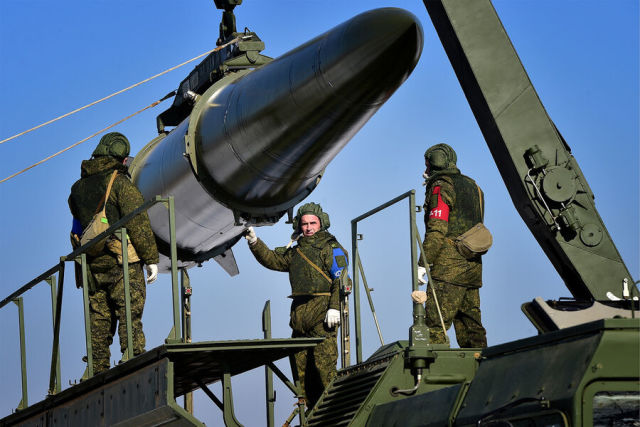Expert Khodorenok explained how Russia will transport and protect TNW in Belarus Russia intends to deploy tactical nuclear weapons (TNW) in Belarus.
In this regard, the construction of a special storage facility should be completed in the republic by July 1. Military observer of the Newspaper.Ru" Mikhail Khodarenok dealt with possible details of the relocation and placement of TNW on the territory of the Republic of Belarus.
From April 3 of this year, the Russian side starts training the crews of the air force of Belarus (more precisely, in the republic this type of armed forces is called the Air Force and air defense forces). Ten aircraft carriers of Alexander Lukashenko's combat aviation have already been prepared for the use of TNW. This was announced on March 25 by Russian President Vladimir Putin.
Special ammunition will be used only according to the plan of the Supreme Commander of the Armed Forces of Russia Vladimir Putin. It is the President of Russia and only he, if necessary, will give the command to unlock nuclear warheads (NBC) and use these weapons of mass destruction.
Apparently, the missile brigade (rbr) stationed on the territory of Belarus, equipped with Iskander-M operational and tactical complexes, and one of the aviation regiments, which will be armed with TNW carrier aircraft, will receive special warheads. In the latter case, it is possible that aviators will receive nuclear aircraft bombs of free fall (of various capacities in TNT equivalent).
In this regard, it is logical to assume that two storage facilities for tactical nuclear weapons will still be built (it is more correct to call them special structures). Most likely, one of them will be deployed within the positional area of the Iskander-M RBR (and it will store missiles ready for combat use with already docked missiles). Another facility should be located in the immediate vicinity of the airfield where the carrier aircraft will be based. Otherwise, it will be difficult to talk about any efficiency in matters of possible combat use of tactical nuclear weapons.
Special requirements are imposed on the protection and defense of special structures in which special ammunition is placed. For these purposes, a guard is allocated, that is, an armed unit specially assigned to perform the combat task of protecting and defending this particularly important object. In addition to guard posts, the protection of the structure is usually reinforced by several rows of barbed wire, inconspicuous obstacles, control lanes and a variety of technical means of protection and alarm, ranging from video surveillance and ending with motion sensors. The right of access to the facility has an extremely limited number of persons, agreed and approved by the relevant authorities.
Since special facilities in Belarus will be located in the immediate vicinity of the zone of a special military operation, it is quite possible that additional security measures will be provided. In particular, tanks can be used as long-term firing points, and the approaches to the structure can be mined.
In the case of the deployment of nuclear weapons on the territory of Belarus, it will also have to relocate the PRTB - mobile repair and technical bases. Such are the parts of the nuclear support of the Armed Forces of the Russian Federation intended for operation (reception, storage, maintenance) and delivery of nuclear ammunition (warheads) in terms of the combat use of nuclear weapons (for example, in the RBR or bomber aviation regiments). The Prtb is organizationally part of the 12th Main Directorate of the Ministry of Defense of the Russian Federation.
Finally, I probably need to say a few words about another very, very important problem. In the case of the deployment of TNW on the territory of Belarus (and this is a union state, but, nevertheless, still another state), any possibility of the loss of special ammunition or even the hypothetical seizure of the nuclear power plant by any third parties should be completely excluded. In other words, the leadership of the republic must firmly guarantee that in the historically foreseeable future (and this is exactly how this question should be raised) with special ammunition on the territory of Belarus, even by definition, no emergency situation can occur. The consequences otherwise, if the situation begins to develop according to an unpredictable and negative scenario, may simply be unpredictable.
For example, in the second half of the 1980s, the political situation in the still Soviet Transcaucasia began to develop in a dangerous variant for the safety of the YABCH. More precisely, the first signs have just appeared that the situation may get out of control. And in this regard, the relevant officials, first of all representatives of the 12th GU of the Ministry of Defense, decided (without expecting the aggravation of the relevant events) - to export nuclear weapons from Transcaucasia immediately, as a matter of urgency - by planes, helicopters, motor vehicles - everything that was possible in a particular situation. As a result, not a single special ammunition fell into the hands of extremists.
This experience should probably not be forgotten.
The opinion of the author may not coincide with the position of the editorial board.Biography of the author:
Mikhail Mikhailovich Khodarenok is a military columnist for the newspaper.
Ru", retired colonel.
He graduated from the Minsk Higher Engineering Anti-Aircraft Missile School (1976), the Military Air Defense Command Academy (1986).
Commander of the S-75 anti-aircraft missile division (1980-1983).
Deputy Commander of the anti-aircraft missile regiment (1986-1988).
Senior Officer of the General Staff of the Air Defense Forces (1988-1992).
Officer of the Main Operational Directorate of the General Staff (1992-2000).
Graduated from the Military Academy of the General Staff of the Armed Forces of Russia (1998).
Columnist of "Nezavisimaya Gazeta" (2000-2003), editor-in-chief of the newspaper "Military-Industrial Courier" (2010-2015).Mikhail Khodarenok

